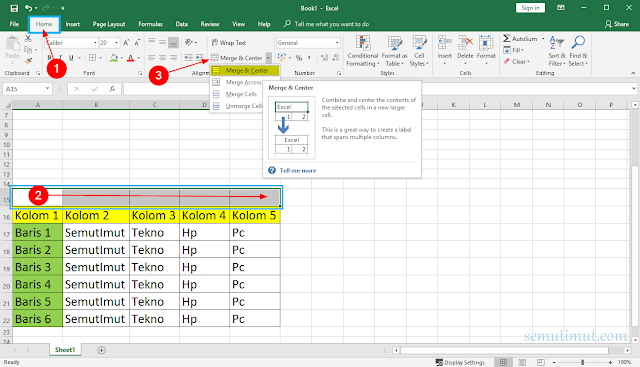Excel is a widely used software for data analysis and management. It is able to perform complex calculations, generate graphs and charts, and provide insights into data. In this article, we will go through some useful tips and tricks for using Microsoft Excel.
Cara Buat Invoice Guna Excel
Creating invoices is an important aspect of running a business, and Microsoft Excel is a great tool for this task. Here are some steps to create an invoice using Excel:
- Open Microsoft Excel and create a new spreadsheet.
- Enter the necessary information for the invoice, such as the name of your company, the name of the client, and the date.
- Create a table with columns for the item name, quantity, price, and total.
- Enter the details for each item that you are invoicing for.
- Calculate the total amount due by summing up the totals for each item.
- Add any additional information, such as payment terms and contact information.
- Save the invoice as a PDF or print it out to send to the client.
Cara Mengoperasikan Microsoft Excel Untuk Pemula Yang Baru Belajar
Microsoft Excel can be daunting for beginners, but with a little practice, it can become a valuable tool. Here are some basic tips for using Microsoft Excel:
- Understand the interface: Excel is made up of a grid of cells, which are organized into rows and columns. Each cell is identified by a unique combination of a column letter and a row number.
- Create a spreadsheet: To create a new spreadsheet, open Excel and select “New Workbook” from the File menu. Enter the necessary information into the cells, such as names, dates, and values.
- Formatting cells: You can format cells to change the appearance of the data within them. For example, you can change the font size, add borders, and change the background color.
- Performing calculations: Excel is known for its ability to perform complex calculations. To perform a calculation, simply enter the formula into a cell. For example, “=A1+B1” will add the values in cells A1 and B1.
- Creating charts: Excel can also create charts and graphs to visualize data. Select the data that you want to create a chart for, and then select the chart type from the Insert menu.
- Sorting and filtering: Excel allows you to sort and filter data to make it easier to analyze. Select the column that you want to sort or filter, and then select the appropriate option from the Data menu.
Cara Menghilangkan Garis di Microsoft Excel
When creating tables or charts in Excel, it is common to have gridlines or borders displayed. However, in some cases, these lines can be distracting or unnecessary. Here’s how to remove the lines:
- Select the cells that you want to remove the lines from.
- Right-click on the selection and choose “Format Cells” from the menu.
- Select the “Border” tab.
- Select “None” from the drop-down list under “Border.” This will remove all of the lines from the selected cells.
Cara Membuat Watermark di Excel Transparan Tulisan & Logo
A watermark is a translucent image or text that is overlaid on top of a document. It is often used to indicate that the document is confidential or a draft version. Here’s how to add a watermark to an Excel spreadsheet:
- Click on the “Page Layout” tab in the Excel ribbon.
- Select “Watermark” from the “Page Background” group.
- Select “Custom Watermark.”
- Choose whether to create a picture or text watermark.
- Select the picture or enter the text that you want to use as the watermark.
- Select the opacity and scale of the watermark.
FAQ
1. How can I use Excel for data analysis?
Excel is a powerful tool for data analysis. Here are some steps to get started:
- Import your data: Import your data into Excel using the “Import Data” or “From Text” options.
- Clean your data: Excel provides tools to clean and transform your data, such as removing duplicates, fill in missing values, or split data into columns.
- Analyze your data: Use Excel’s formulas, functions, and pivot tables to analyze your data. Formulas can be used to calculate statistics, handle missing values or create new variables. Pivot tables can be used to summarize and visualize your data.
- Visualize your data: Create charts, graphs, or histograms to visualize your data. Excel provides a wide variety of chart types and customization options.
2. How can I speed up my work in Excel?
Excel can be time-consuming, but there are ways to speed up your work. Here are some tips:
- Use keyboard shortcuts: Excel has many keyboard shortcuts to save you time. For example, press “Ctrl + C” to copy a cell and “Ctrl + V” to paste it.
- Use templates: Excel provides many templates for common tasks, such as budgets, invoices, and calendars. Use these to save time and avoid starting from scratch.
- Use macros: Macros are recordings of a series of commands that you can replay to automate repetitive tasks. Record a macro for a task you need to do frequently, and then run it whenever you need to repeat the task.
- Use named ranges: Named ranges can make it easier to work with complex formulas and charts. Instead of using cell references, define a name for a range of cells.
- Use conditional formatting: Conditional formatting allows you to highlight cells that meet certain criteria. This can make it easier to find outliers or patterns in your data.



